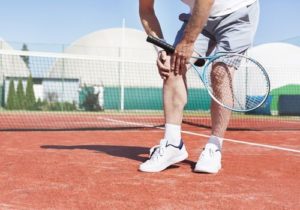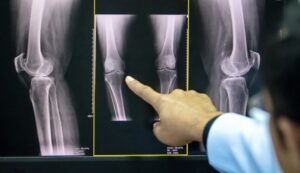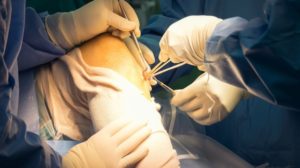Are you worried about the risk of ACL injuries while playing tennis?
Do you want to know how to prevent and recover from these injuries so you can continue playing at your best?
Tennis is a tremendous sport that requires the player to have agility, co-ordination, strength and endurance if he/she wants to be the best.
There is a variety of movements that a player performs while playing tennis; like:
- Jumping,
- Running (forward, backward, and sideways),
- Quick turns etc.
The variety of these movements makes the player susceptible to a number of injuries in lower limb such as:
- Achilles Tendonitis,
- Plantar Fasciitis,
- Jumper’s Knee, and
- Ankle Sprains etc.
Anterior Cruciate Ligament tear, Medical Collateral Ligament and Posterior Cruciate Ligament injury is also seen among tennis players.
In this article, I will focus on Anterior Cruciate Ligament tear or injury.
And if you’d like to jump straight and read about the latest successful ACL knee rehabilitation case I just completed then click on the link below and learn more about Nikki’s ACL injury rehabilitation experience.
ACL Injury in Tennis Players
Anterior Cruciate Ligament tear is much more common in tennis players than a posterior cruciate ligament injury.
- Did you know that this study reported 1.8% overall ACL rupture incidence from tennis related injuries? [1]
In case you do not know, ACL is a ligament present in your knee joint that prevents excessive forward translation of your shin bone.
This ligament can be injured either because of direct trauma (contact mechanism) to your knee or twisting movements at the knee (non-contact mechanism).
Torn ACL with meniscus injury is also a common finding among tennis players because of the mechanism of injury.
The most common non-contact mechanism responsible for ACL injury is the excessive inward movement of your knee joint while your foot is fixed on the ground.
We all know that the ability to perform well in tennis is tied to the ability to change direction fast and move their body weight as quickly as possible.

Unfortunately, this rapid change of direction while your foot is fixed on the ground (twisting movement of the knee) may lead to ACL injury.
This commonly happens during landing from a jump especially on the non-dominant foot.
Trying to stop immediately and change the direction can also result in torn ACL with meniscus injury among tennis players.
ACL injury treatment depends upon the severity of injury and several patient-related factors.
If you have recently suffered a knee injury that resulted in ACL tear or rupture, you can book now a FREE CONSULTATION session with Jazz Alessi to discuss your limitations and successful knee injury rehabilitation options.
Consequences of ACL injury in Tennis Players
As you know that the major purpose of ACL is to provide stability to the knee joint, you can expect a decrease in stability if you somehow injure your ACL and do not seek ACL injury treatment.
As the knee joint bears a considerable amount of weight during tennis, a decline in player’s performance is evident.
Both of the ligaments (ACL and PCL) serve the purpose of keeping your knee joint in place but an Anterior Cruciate Ligament injury does more damage than a Posterior Cruciate Ligament Injury.
If you have a question “Can you play tennis having torn ACL with meniscus injury?” then you must know the areas of tennis that are affected when your ACL is injured.
Some of the most commonly affected areas are as follows [2]
- Landing after a smash stroke
- Stopping abruptly
- Changing direction;
- Playing on hard courts

Are you facing similar issues while playing tennis?
Why not discuss these issues with a knee injury rehab specialist, elite personal trainer London based and that too for FREE?
- Book a FREE CONSULTATION
One of the most evident problem seen among tennis players following ACL injury is the lack of confidence in landing after hitting a smash.
- Did you know that some tennis players with ACL injury may start avoiding the smash?
Tennis players with injured ACL also show major limitations when trying to “stop suddenly and change direction”.
- This happens because this type of movement creates high anterior loading on player’s knee joint, a movement that is controlled by the ACL. [3]
It also becomes difficult for the players to play on hard courts.
- This shows that the forward and rotational knee moments are thought to be increased when playing on hard surfaces due to greater friction between the foot and the ground. [4]
2021 Wimbledon Tournament and Injuries
As you all know that Wimbledon Tournament 2021 is on the run nowadays and players around the globe are competing against one another to achieve the mega title.
Though high performance is the need of the hour but a minor fault in the technique may lead to an injury ultimately resulting in decline in performance or probably failure to compete.
Few such injuries have taken place during this tournament and as a tennis player, you should know about these.
Serena Williams – The Undisputed Champion
Serena, an American professional tennis player was also taking part in this tournament.
She is the former world No. 1 in women’s single tennis.
Serena has won 23 Grand Slam singles titles, the most by any player in the Open Era and the second most of all time.
She suffered from an ankle injury during the first round and unfortunately had to retire from the match shortly after the ankle injury.

Adrian Mannarino, a French player also sustained a knee injury in the fourth set during a thrilling match against Roger Federer.
He had to leave the court during 5th set because of that injury.
These types of injuries are not new and tennis stars like Maria Sharapova, Victoria Azarenka and Caroline Wozniacki were also injured after slipping on the field.
Roger Federer – A True Champion
How can we forget about Roger Federer when we are talking about tennis?
He has been a world no. 1 tennis player in the ATP rankings a total of 310 weeks and has won 20 Grand Slam men’s single titles.
Though he is a star player, but he is also not immune to injuries in the field and has suffered from a number of injuries in his career:
- a foot injury at Indian Wells 2007,
- back injury at Tennis Master Cup 2008 and Wimbledon 2012,
- leg injury at Wimbledon 2010,
- groin strain at Halle 2011 etc.
Emma Raducanu – An Emerging Player
Emma Raducanu is an emerging British Tennis Playe and the youngest British woman to reach the last 16 players in the Open Era.
She is the youngest British woman to reach the Wimbledon third round since Elena Baltacha in 2002.
Unfortunately, she had to retire in the second set of her fourth round match due to some sort of breathing difficulty.
No matter what the cause is, not a single tennis player whether a senior like Serena, Roger Federer or a young player like Emma Raducanu, wants to face these kinds of injuries and that’s why they do their best in their training sessions, preparing for the big tournaments like Wimbledon.
There is a fact I believe that as a tennis player, you can take a number of precautions to reduce the risks of injury but as you target the title you can never completely nullify the possibilities of having an injury, no matter whatever you do.
Don’t you agree with me?
I’m sure that you do.
But the thing that is more important is HOW YOU BULLET PROOF YOUR KNEE TO PREVENT RE-INJURIES and THE WAY YOU RESPOND TO AN INJURY.
- Do you want to learn about that from a highly qualified rehab trainer and long-term experienced elite personal trainer in London?
Book now a FREE CONSULTATION !
ACL Reconstruction in Tennis Players
As you already know the hazards of torn ACL among tennis players, we must take this problem very seriously and immediately seek for ACL injury treatment.
Though minor ACL injuries get better with some rest and supervised rehabilitation, major injuries of ACL require surgery i.e. ACL reconstruction
There has been a huge increase in the number of ACL reconstruction procedures in recent years, with more than 200,000 being performed in 2014 alone. [5]
A supervised ACL rehab for tennis players following ACL reconstruction is paramount for achieving better outcomes of the surgery and return to tennis after ACL surgery.

- If you are thinking that whether you should opt for ACL reconstruction surgery or not, you must know this important fact that approximately 86% of anterior forces around the knee are considered to be restrained by the ACL. [6]
If your ACL is damaged, this can also result in other injuries such as:
- Meniscal tears,
- Medial Collateral Ligament (MCL) injury and
- early onset of knee osteoarthritis. [7]
Customised ACL Rehabilitation in Tennis Injury – Why is it Important?
You will agree with this fact that all of us are different.
We have different thoughts, different emotions, different abilities and strengths and so on.
Just like this, our bodies are different too and need to be treated and trained differently.
Though mechanism of ACL injury can be same in most of the tennis players, the rehabilitation programme following ACL reconstruction must be tailored according to the player’s needs and specific knee demands.
- A trainer must keep in view the player’s techniques and the demands placed on his knees and must design a plan that aim to bring the best out of his client.

A customised rehabilitation programme for a tennis player can help in several ways.
It helps to:
- Decrease the chances of reinjury
- Improvement in strength and endurance of leg muscles.
- Improvements in techniques
- Safe and faster return to tennis
- Eliminate anxiety and stress and dramatically improves confidence and mental health
Did you know that…
- The customised knee rehabilitation programme I provide to my clients following ACL reconstruction helps the players go back on the court twice as strong, versatile in their movements and about twice as fast before their ACL injury?
If you care about your performance and I’m sure you do, why not discuss your goals with a specialist rehab trainer and elite personal trainer in London by booking now a FREE COSULTATION
7 things to Avoid after ACL Surgery among Tennis Players
The importance of rehabilitation programme following the Anterior Cruciate Ligament reconstruction surgery cannot be neglected.
- Several personal trainers talk or write about WHAT YOU NEED TO DO to speed up your recovery after ACL surgery but very few personal trainers enlighten their clients about WHAT THEY NEED TO AVOID after Anterior Cruciate Ligament Reconstruction.
Anterior Cruciate Ligament Reconstruction surgery is usually performed for managing complete anterior cruciate ligament rupture and that’s why you must be very careful during the rehabilitation programme.
My article will focus on 7 important things that you must avoid if you want your ACL to recover fully after undergoing Anterior Cruciate Ligament Reconstruction surgery.
Let’s have a look at these things one by one.
1. Prolonged use of Knee Immobiliser
When a surgery is performed to fix the anterior cruciate ligament rupture or a posterior cruciate ligament tear, a knee immobiliser is recommended to wear around the knee for some time.
The purpose of this knee immobiliser (as the name indicates) is to restrict the motion at the knee joint so that the newly repaired ACL does not face any stress.
Wearing knee immobiliser is necessary but you must remove it for some time and perform some exercises to maintain your knee’s range of motion in early days of recovery. [8]
The mistake most of the people who undergo ACL surgery do is that they continue to wear the knee immobiliser and do not remove it at all in early days of recovery.
They are of the view that this is meant to keep their knee and ACL safe but it does more harm than good.
Prolonged use of knee immobiliser may result in:
- Stiffness, not only in the knee joint but also in hip and ankle joints.
- Swelling around knee and ankle joint.
- Weakness and atrophy of quadriceps muscles
- Pain
It is recommended to continue to remove your leg from the knee immobiliser 4 to 6 times a day for at least 10 minutes at a time and perform safe knee exercises to maintain knee range of motion.
2. Prolonged Sitting with Knee in Dependent Position
The next important thing you need to avoid is “prolonged sitting with knee in dependent position”.
It doesn’t mean that you need to lie on bed all day long and do not move at all.
Changing positions from lying to sitting and sitting to standing is good for recovery but you must do it in a proper way.
Shouldn’t you?
- The major concern here is to avoid swelling around your knee joint.
- Swelling is commonly seen around the knee joint following ACL surgery and you are advised to keep your feet slightly higher than your heart level to reduce it.

- When you keep your feet above your heart’s level, it assists in venous return and that’s how it results in reduction of the swelling.
Now, if you sit for prolonged time with your knee in dependent position, it would affect your venous return and chances of swelling are increased.
- If you have to sit for any significant period of time, it is advised to elevate your leg and foot.
3. Hamstring muscles Stretching (4-6 weeks)
One of the most important things to avoid following ACL surgery is the hamstring muscles stretching exercises for few weeks if the hamstring muscles-tendon graft was used for ACL reconstruction.
When a torn ACL is reconstructed, a portion of your hamstring muscles tendon is taken for this purpose.
This obviously weakens the hamstring muscles to some extent.
This weakness doesn’t persist for long and the muscles usually return to their normal strength levels after some time.
- The important point to note here is that you should not perform any hamstring muscles stretching exercises in early weeks of recovery as it may injure your hamstring muscles and complicate the recovery. [8]
- It is recommended to avoid excessive stretching of the hamstring muscles during the first 6 weeks after surgery as hamstring muscles need about 4 to 6 weeks for completely recovery.
Excessive stretching during this time can result in hamstring muscles pulling, pain and injury.
4. Use of pillow under your affected Knee
Another common mistake I want you to warn about is the use of pillow under your affected knee.
When knee immobiliser is removed, people usually place a pillow under their affected knee as this position seems relieving.
- Though it may provide relief in pain for time-being, this can cause stiffness in your hamstring muscles and weakness in quadriceps muscles.
Weakness in quadriceps muscles is not good at all for your ACL recovery.

The most noticeable things in this regard is that the terminal extension of affected knee is compromised and you may not be able to straighten your knee completely if placing the pillow under the knee becomes a habit.
- IF the purpose of placing pillow under your knee is to elevate it, you should place the pillow under your heel or calf.
This will not only keep your knee straight but also helps in minimising the swelling.
5. Full Squats
I’m sure that you must be well aware of this exercise.
This exercise is performed to strengthen your quadriceps muscles.
Strengthening your quadriceps muscles is crucial while rehabilitating after ACL surgery but you must choose the strengthening exercises cautiously.
Your ACL faces considerable stress when your shin bone is moving in forward direction.
This is what happens when you perform a full squat i.e. your shin bone moves in forward direction.
- This is why you must not perform this exercise in early phase of recovery.
It is advised to delay this sort of exercises especially during early phases of recovery.
- Alternatively, you can perform “half-squats” but that too VERY carefully.
6. Car Driving
I understand quite well the importance of returning to normal daily activities but you must be very cautious about it.
You should know when it is safe to return to a particular activity following anterior cruciate ligament rupture and surgery.
One such activity is car driving.
You should not drive a car in early days/weeks of recovery if you right knee is affected, even if you drive an automatic car.
However If your left knee is affected, you may drive a car with automatic transmission when you can comfortably get the leg in and out of the car. [8]
- Driving a manual transmission car is not recommended unless good muscular control is developed within the legs and thighs.
This may take 2-4 weeks.
7. Jumping and twisting movements
The last important thing to avoid following Anterior Cruciate Ligament reconstruction surgery is the jumping and twisting movements as it affects your healing ACL.
You must be very cautious about the twisting movements at the knee such as during getting in and out of the car.
Explosive movements such as jumping and running are advised only in terminal phases of rehabilitation and that’s why you must avoid them during early phases of recovery.
If you want to know whether you can start such activities or not, discuss your current knee injury status with Jazz Alessi, an elite personal trainer in London and see if this is the right to return to such explosive movements.
Book your FREE CONSULTATION now.
Conclusion
ACL injuries are very much common among the tennis players as compared to posterior cruciate ligament tear and this is commonly managed by ACL reconstruction surgeries.
It is not possible to return to sport immediately following the surgery as it is a gradual process carried out under the supervision of a professional rehab trainer.
You must be very cautious about the things you need to avoid during your rehabilitation phase as this is going to affect your performance and athleticism in the future.
Who is Jazz Alessi?
Jazz Alessi is an elite personal trainer in London having a wide range of expertise and he has been training some of the best athletes in the world from more than 20 years.
He is a specialist rehab trainer, sports nutritionist, clinical exercise specialist and 2nd generation Pilates Trainer.
He is not only an expert in ACL and other ligaments reconstruction rehabilitation but also an experienced professional who has previously worked with Olympic Athletes, Tennis Players, Marathon runners, Football Players etc.
Apart from his expertise in rehabilitation following ACL surgery, he is an knee injury rehabilitation expert and can offer training sessions tailored to minimising the risks injuries in tennis, football and other sports.
Whether it is ACL reconstruction rehab or injury prevention strategies, he is a jack of all trades.
Want to know more about Jazz Alessi’s services?
Get in touch by clicking on this link now.
REFERENCES
- Kuhne, C., R. Zettl, and D. Nast-Kolb, Tennis injuries-Pattern and incidence in competitive and leisure tennis sports. SPORTVERLETZUNG SPORTSCHADEN, 2004. 1(2): p. 85-89.
- Maquirriain, J. and P. Megey, Tennis specific limitations in players with an ACL deficient knee. British journal of sports medicine, 2006. 40(5): p. 451-453.
- Steele, J. and J. Brown, Effects of chronic anterior cruciate ligament deficiency on muscle activation patterns during an abrupt deceleration task. Clinical Biomechanics, 1999. 14(4): p. 247-257.
- Nigg, B. and B. Segesser, The influence of playing surfaces on the load on the locomotor system and on football and tennis injuries. Sports medicine, 1988. 5(6): p. 375-385.
- Paschos, N.K. and S.M. Howell, Anterior cruciate ligament reconstruction: principles of treatment. EFORT open reviews, 2016. 1(11): p. 398-408.
- Besier, T.F., et al., External loading of the knee joint during running and cutting maneuvers. Medicine and science in sports and exercise, 2001. 33(7): p. 1168-1175.
- Kisner, C., L.A. Colby, and J. Borstad, Therapeutic exercise: foundations and techniques. 2017: Fa Davis.
- Millett, P.J. and C. Vail, ACL reconstruction rehabilitation protocol. Sport Med [Internet], 2010. 1: p. 151.



